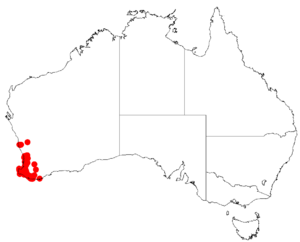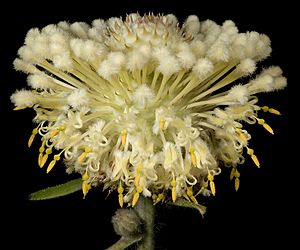Drumstick isopogon facts for kids
Quick facts for kids Drumstick isopogon |
|
|---|---|
 |
|
| In John Forrest National Park | |
| Scientific classification | |
| Genus: |
Isopogon
|
| Species: |
sphaerocephalus
|
 |
|
| Occurrence data from Australasian Virtual Herbarium | |
| Synonyms | |
|
|
Isopogon sphaerocephalus, also known as the drumstick isopogon or Lesueur isopogon, is a special plant found only in the south-west part of Western Australia. It belongs to the Proteaceae family, which includes many unique Australian plants. This plant is a type of shrub that has long, narrow leaves and round, fluffy white or creamy yellow flowers.
What Does It Look Like?
The drumstick isopogon is a shrub that can grow from about 0.3 to 2 meters tall. Its young branches and new leaves are often covered in fine hairs.
The leaves are shaped like a narrow egg or a line. They are usually between 50 and 160 millimeters long and 4 to 18 millimeters wide. Each leaf has a tiny point at its end.
The flowers grow in round, ball-shaped clusters at the ends of the branches. These flower heads are about 25 to 30 millimeters wide. At the bottom of each flower head, there are hairy, egg-shaped leaves called bracts. The flowers themselves are very hairy and can be white, pale, or creamy yellow. They grow up to 15 millimeters long.
This plant usually flowers between July and January. After flowering, it produces a hairy fruit that looks like a small nut. These nuts are joined together in a cone-shaped or oblong head, about 20 to 30 millimeters wide.
How It Got Its Name
The plant Isopogon sphaerocephalus was first officially described in 1839. This was done by a botanist named John Lindley in his book A sketch of the vegetation of the Swan River Colony.
The name sphaerocephalus comes from Greek words meaning "spherical-headed." This describes the plant's round flower heads. The name lesueurensis refers to Mount Lesueur, a place where one type of this plant grows.
Where Does It Grow?
The drumstick isopogon grows in different areas of Western Australia. One type, called sphaerocephalus, is found in Jarrah forests. These forests are located between areas like Gidgegannup, the Scott River, and the Kent River.
Another type, called lesueurensis, grows in shrublands. These are areas with many shrubs, often found on or near hillsides in the Mount Lesueur area.
Is It Safe?
Both types of Isopogon sphaerocephalus are considered "not threatened" by the Western Australian Government's Department of Parks and Wildlife. This means they are not currently at risk of disappearing.


